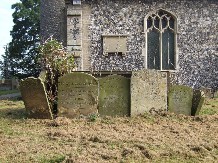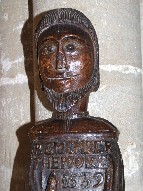| |
|
St Mary,
Watton
 |
|
Watton
is one of the most pleasing of Norfolk's small
towns. It is little known by outsiders, not least
because it is isolated on the edge of the British
Army's battle training area. Nineteenth Century
Watton was prosperous, with a modicum of civic
pride. Perhaps the best evocation of Watton in
those times is in DJ Taylor's haunting novel Kept.
But this part of East Anglia, the Breckland, fell
on hard times in the 1980s and 1990s.
Unemployment was high, and the area has one of
the lowest proportions of adults who have been
through Higher Education in the country. By the
early 1990s, the once-busy High Street was lined
with boarded up shops. The opening
of a large new prison on the old airfield
provided some jobs, but it was not until a large
injection from the European Social Fund that the
area really took off. The Wayland Initiative
focused on developing the area for tourism,
presenting Watton as the heart of an area of
rolling woods and interesting villages. At the
entrance to the villages, the village name signs
have a corporate identity, with the Wayland logo,
as if this was some minor East Anglian Ruritania.
But it seems to have worked: today, Watton High
Street is proudly busy again.
|
As part of
the Initiative, the local churches were encouraged to be
open, or at least accessible. It took some of them longer
than others to come around to this way of thinking, but
today, at last, virtually all of the Watton area churches
have either keyholder notices or open doors. St Mary is
open when the parish office, in an extension on the north
side, is open. At other times, there is a key.
The church
sits on the edge of the town on the road to Dereham, and
it is that unusual thing, an urban round-towered church.
There are only about half a dozen of these left in East
Anglia, because most urban churches underwent
considerable renewal during the medieval period. However,
at first glance it is obvious that the major rebuilding
work here was done at a much later date. The little 13th
Century church is flanked by two massive 19th century
aisles. It is as if three churches had been joined
together side by side, and reminds me of boats floating
in a bunch, tied together. As if in sympathy, older
headstones in the graveyard have also been collected
together into bunches, to allow for easy mowing.
As you
would expect, you step into an interior which is almost
entirely Victorian, but it is actually more interesting
than it first appears, because the massive rebuilding of
this church happened in 1840. The aisles were built to
accomodate an extra 220 seats in what was still a kind of
preaching box: there is no view into the chancel from
most of the church. The great wave of enthusiasm,
generated by the Oxford Movement and the Camden Society,
to restore our parish churches to their medieval
integrity with a focus on the altar, had still to reach
this lonely place; and so, this is one of the last
pre-Ecclesiological restorations in England.
| The
later Victorians would also leave their mark,
with a pretty screen and some fairly middlebrow
glass. But the unforgettable feature of the
interior is the lovely poorbox of 1639, aparently
carved in effigy of the Minister of the time. He
is depicted holding a bag of money and with a
smile on his face; his chest is carved with the
familiar invocation to Remember the Poore.
This encouragement of charity was an important
part of the Puritan project of the time: it
wasn't all smashing glass and beheading Kings.
However, if you compare this naive little
folk-carving with the fabulous art being produced
as a result of the Renaissance at this time in
the rest of Europe, you can't help thinking that
we paid a high price for Puritanism. There are
some moving WWI memorials in the south aisle, and
out in the graveyard there is a great curiosity:
a wooden WWI cross memorial to Thomas Edward
Adcock, the son of Mr. and Mrs. W. J. Adcock, of
West End Terrace in Watton. A resident of
Gorleston-on-Sea, he had enlisted in the Norfolk
Regiment on 3rd August, 1914. This was the day
before the War broke out, and he was 20 years
old. Amazingly, he survived almost the entire
Great War, to be killed just a month before the
Armistice. His is one of 190 Commonwealth war
dead bodies to lie at Underhill Cemetery near
Ypres in Belgium, on the north-western edge of
Ploegsteert Wood.
|
|
 |
|
|
|
